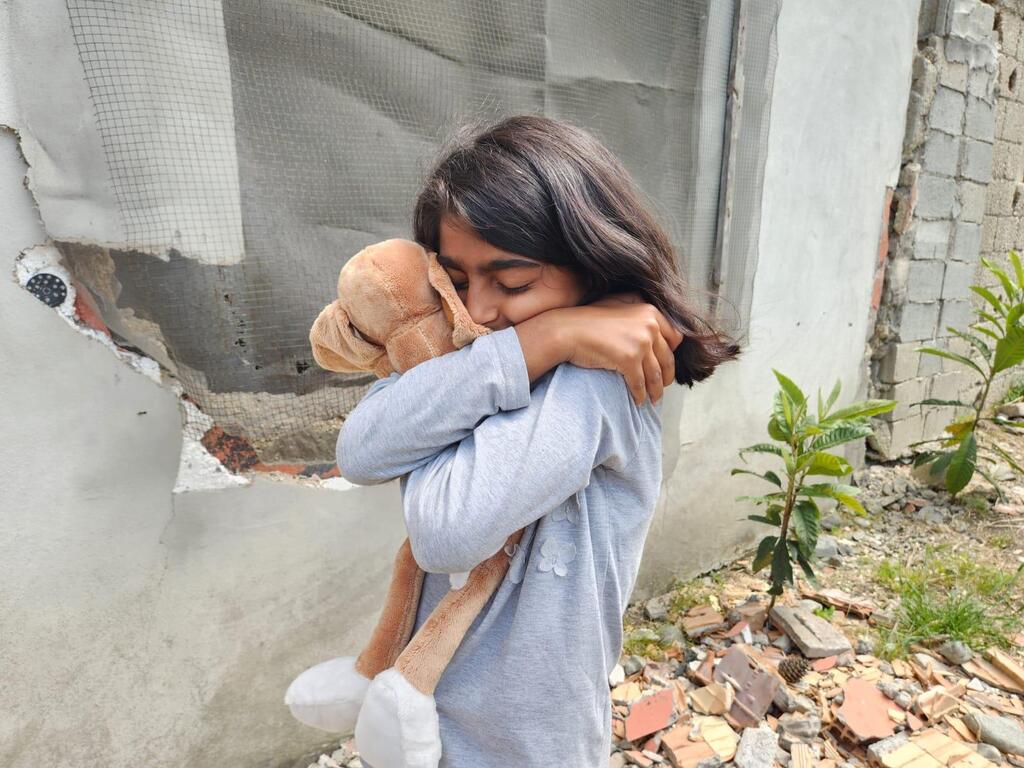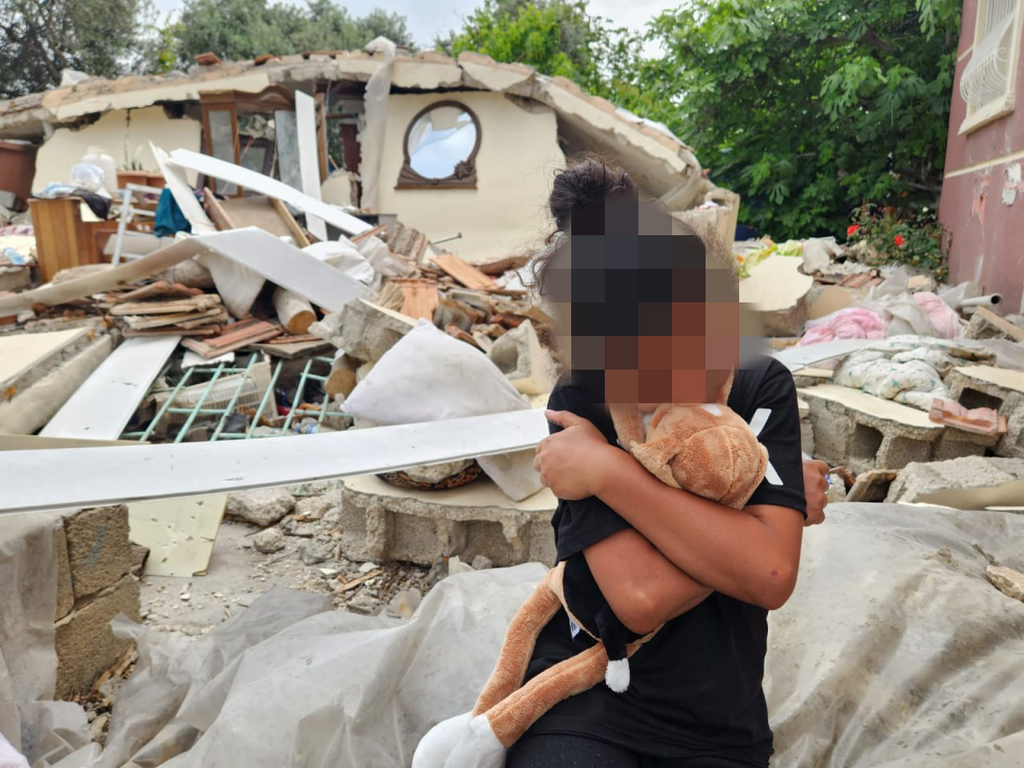Upon closer examination, Hibuki (derived from the Hebrew word for "hug") may appear to be just an ordinary doll, easily loved by small children and often forgotten in adulthood. However, this doll holds a much deeper significance. It serves as a vital tool within a preventive strategic intervention program, aimed at reducing anxiety and distress in children who have experienced trauma.
Read more:
These cuddly dolls possess unique features: sorrowful eyes, long arms secured with scotch tape, and a face that combines elements of both a puppy and a human. The expressive eyes provide reassurance to the child, letting them know that they are not alone in their sadness. Hibuki, in this instance, becomes a relatable companion. The extended arms allow for a reciprocal embrace between the doll and the child, while the distinctive face enhances the child's ability to form an emotional connection with the doll and project their feelings onto it.
The therapeutic protocol consists of two stages. In the first stage, children are asked to express how Hibuki feels. They describe Hibuki as sad and project their own fears, longing for a deceased father, missing friends, and other anxieties onto the doll. In the second stage, after releasing their emotions onto the doll, children are encouraged to care for it. If Hibuki is afraid to sleep, the child is prompted to provide comfort through hugs. Singing to Hibuki and calming it is encouraged when the child longs for someone. Additionally, if the child has no appetite, they can try eating together with the doll.
Parents receive guidance to support their child in caring for the doll. Through doll therapy, the child learns to take care of themselves. This occurs for three reasons:
1) Active role: By taking care of someone, the child gains a sense of empowerment. Active coping is beneficial in traumatic situations, as it reduces passivity and anxiety.
2) Diverting attention: The child's attention shifts from their own worries to focusing on the distress and pain of Hibuki. This redirection of concentration allows for a therapeutic experience.
3) Emotional projection: Therapy and play with the doll enable the child to project their emotions onto it. Engaging in play itself has therapeutic qualities.
The program was developed during the Second Lebanon War by Dr. Shai Chen Gal and Professor Avi Sadeh. Starting from Operation Cast Lead in 2010, the Ministry of Education, in collaboration with Eshel and other organizations, adopted the project and implemented it among tens of thousands of children in the south.
"The biggest advantage of the therapeutic intervention 'Hibuki' is that we can reach thousands of children in a short period of time, without the need for a wide treatment system to operate it," explains Chen Gal. "We conducted research among children who experienced trauma from war and found that 60%-70% of the children who received Hibuki showed less anxiety and distress compared to children who did not receive the doll."
"Hibuki also resulted in a decreased need for additional treatment. Our findings indicate that the extent of treatment with the doll directly influences the reduction of anxiety and distress. The more the child interacts with the doll, the less anxious they become. Currently, this intervention is the only one in the world that can be efficiently implemented for thousands of children in a short period of time, and its effectiveness is scientifically proven," according to Chen Gal.
Hibuki has gained international recognition for its effectiveness in helping children who have experienced traumatic events. The impact of the doll has been observed in various locations around the world. "After the tsunami in Japan, the project was launched there, providing treatment to hundreds of children and training staff members. During the war in Ukraine, over 900 professionals were trained, and nearly 20,000 children received the therapeutic doll," the doctor said.
"Studies conducted in Ukraine also demonstrated the effectiveness of the intervention in reducing distress. Additionally, following an invitation from a Turkish organization called Mayavakfi, I traveled to southeast Turkey after an earthquake, where approximately 300 children received the doll. Similar to Ukraine, the children in Turkey continue to benefit from the care provided by Hibuki to this day," he explained.
Last week, Dr. Chen Gal visited hotels in Eilat and the Dead Sea to provide the Hibuki intervention program for children from Gaza border-area communities.
"So far, I have been able to help around 300 children who have endured traumatic experiences. I have also provided training to parents and staff members accompanying them. Within just a day or two, I have already received feedback on the effectiveness of the program. Children who previously struggled to fall asleep without their parents are now able to do so. They have also regained their appetite, and those who had been experiencing bedwetting have seen improvement. It is truly heartwarming to witness how this intervention positively impacts the lives of these children."
How did kids who had Hibuki respond when asked how Hibuki is feeling?
"The responses I received were absolutely heart-wrenching. The children expressed their feelings about Hibuki, mentioning that he feels sad because his friends are not with him, he is scared of loud noises, he doesn't want to go back into closed rooms and be alone, and he is afraid of being burned.
"As someone who has provided care for numerous children in Israel and abroad during times of war and disasters, I have never witnessed such a level of distress as I have seen in the children I have met recently. These children have gone through unimaginable and horrifying experiences. They were confined to safe rooms for hours, feeling immense pressure and fear all around them. Some of them have lost friends or family members. These experiences have been truly traumatic, surpassing anything even the most experienced professionals have encountered before," he said.
"I provided care for a young girl who had spent hours in a safe room while there were attempts to break in and shooting happening outside. When I first met her, she was in a severely distressed state, displaying signs of emotional numbness and apathy since Saturday.
 Dr. Shay Chen GalPhoto: Shahar Fleischmann
Dr. Shay Chen GalPhoto: Shahar Fleischmann"She had stopped eating, and her parents were understandably concerned. Prior to this traumatic event, she had been a strong and sociable girl. Initially, she showed no interest in the doll and seemed disconnected from both me and the doll. It was a challenging situation. However, I gently took her hand and placed it on the doll, and in that moment, something clicked for her. She began to feel a connection and started hugging the doll. Since then, she hasn't let go of it for even a second," according to the doctor.
"This particular moment was incredibly moving. Alongside hundreds of professionals, we pause our own lives to provide care and support for those who have experienced unimaginable horrors. We carry with us the weight of their difficult experiences, the moments of terror, and the traumas of the individuals we meet. We all hope that our efforts, no matter how small, can bring some relief to the immense suffering these children have endured."



